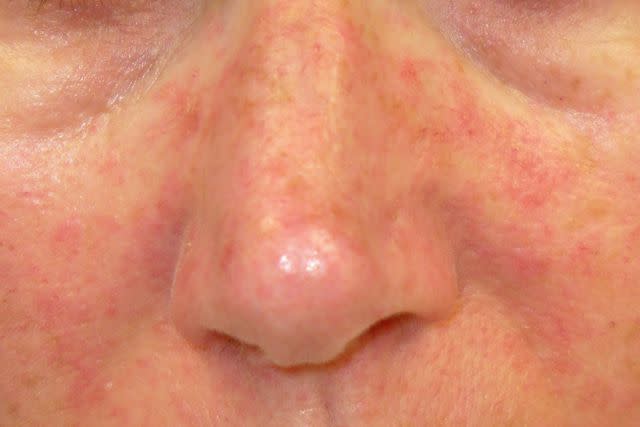Zika Rash: Everything You Need to Know
The rash is made up of small, red dots, but not all patients experience it
Medically reviewed by Brendan Camp, MD
Zika rash is one of the main symptoms of Zika virus, an infection spread by mosquitoes, animal bites, and from person to person via sexual intercourse, blood transfusions, and from a pregnant person to the fetus.
Only about 1 in 5 people develop any Zika virus symptoms. The Zika rash, made up of small, red or purple bumps that often appear on the trunk, arms, legs, and face, is one of the most common symptoms.
Continue reading to learn more about Zika rash and mosquito bites with rash.

Images we create and what actually happens are always beautiful when we have imagination / Getty Images
What Does Zika Rash Look Like?
Zika rash consists of small red or purple dots. It usually first appears on the trunk, although in some people it starts on the face. It then spreads to the arms and legs, or elsewhere on the body.
Characteristics of the rash include:
Red (although like other viral rashes it may look different or purplish on darker skin tones)
Flat, raised, or both
Itchy, with 44% of people reporting itch
Sensitive or painful, with about 3% of people reporting pain

Reproduced with permission from © DermNet dermnetnz.org 2024.
Zika Virus Symptoms
In many people, Zika virus is asymptomatic (without noticeable symptoms). In fact, only about 20% of people infected with the virus experience symptoms, which may or may not include the rash.
Other symptoms of Zika virus include:
Fever
Joint pain
Conjunctivitis (pink eye)
Headache
Although symptoms of Zika are generally mild, the virus can lead to severe pregnancy complications, including what’s sometimes called Zika baby. These can include complications like:
Partial collapse of the baby's skull
Clubfoot
Excessive muscle tone
Damage to the back of the eye
What Causes a Zika Rash?
Zika is caused by a virus from the genus Flavivirus and the family Flaviviridae that is carried by a type of mosquito called Aedes aegypti. In the United States, this mosquito is most often found along the Gulf Coast. Being bitten by a mosquito carrying the Zika virus can cause Zika rash. It’s common for viral infections to cause rashes.
In addition to mosquito bites, Zika can be spread through:
Sexual contact
Blood, including blood transfusions and sharing needles
Pregnancy, from the pregnant person to the fetus
How Is a Zika Rash Diagnosed?
Zika is diagnosed through a blood or urine test. If you believe you have Zika, you should reach out to your healthcare provider. You should also let them know if you have symptoms, including Zika rash or fever, after traveling to regions such as the tropics, where Zika is more common.
How to Treat a Zika Rash
There are no treatments for Zika virus or viral rash. Still, if you have Zika or believe you might, talk with your healthcare provider, especially if you are pregnant or plan to become pregnant.
Although there’s no treatment for Zika rash, some home remedies for itchy skin might help make you more comfortable, including:
Avoid extremely hot water.
Moisturize your skin.
Use a cool compress to alleviate itching.
Try not to scratch.
How Long Does the Zika Virus Last?
The symptoms of Zika usually last from two to seven days. However, the rash can linger for a bit longer. A research review of 66 cases found that people usually have Zika rash for three to eleven days, with the average length being six days.
Possible Complications of Zika
Although Zika is a mild virus, it can lead to significant pregnancy complications. Research shows that about 5% of people who have contracted the Zika virus while pregnant have had a child with Zika-related complications. Those complications include:
Miscarriage (losing the fetus before 20 weeks' gestation) and stillbirth (losing the fetus after 20 weeks' gestation)
Microcephaly (extremely small head size)
Other congenital conditions
In addition, in rare cases, Zika can cause Guillain-Barré syndrome, an autoimmune disorder that affects the nerves and can lead to paralysis.
What’s the Outlook for Someone With Zika Rash?
For most people, Zika rash is a minor concern that will clear up on its own within about a week. However, if you are pregnant or plan to become pregnant and have Zika rash, you should see your medical provider. Pregnant people who experience Zika will need additional monitoring to look for pregnancy complications.
How to Prevent Zika
While it’s never possible to eliminate all risks for a virus, these measures can help you avoid Zika rash:
Minimize travel to areas with Zika, including the Gulf Coast of the United States, the Caribbean, and Central America.
Use bug spray and wear long sleeves, particularly at dusk and other times with heavy mosquito activity.
Stay indoors with air-conditioning running during periods of high mosquito activity if you’re in an area with a Zika outbreak.
Practice safer sex, including condom use for oral sex on a male partner.
Never share needles or otherwise expose yourself to someone else’s blood.
Summary
Zika rash is a common symptom of Zika virus, an infection spread through mosquito bites and person-to-person transmission. Zika rash consists of small red or purple dots, which may be flat or raised. The rash is often itchy. In most people, Zika rash is mild and will resolve on its own within a week. However, Zika can cause serious complications in pregnant people.
If you are pregnant or plan to become pregnant and have Zika rash, reach out to your healthcare provider, who will likely recommend extra monitoring to detect any Zika-related pregnancy complications.
Read the original article on Verywell Health.


